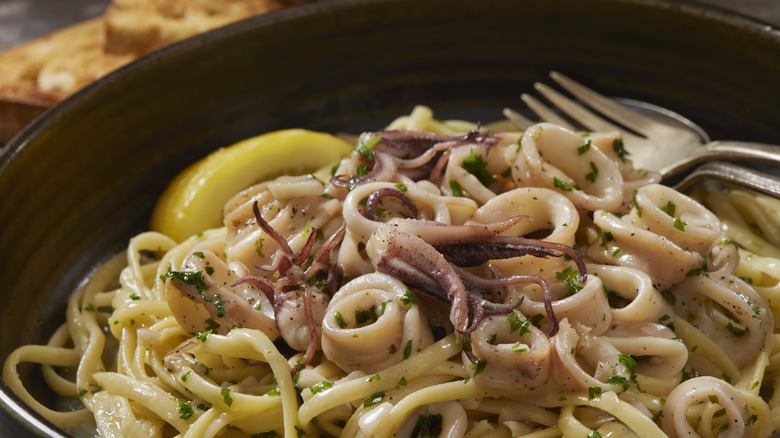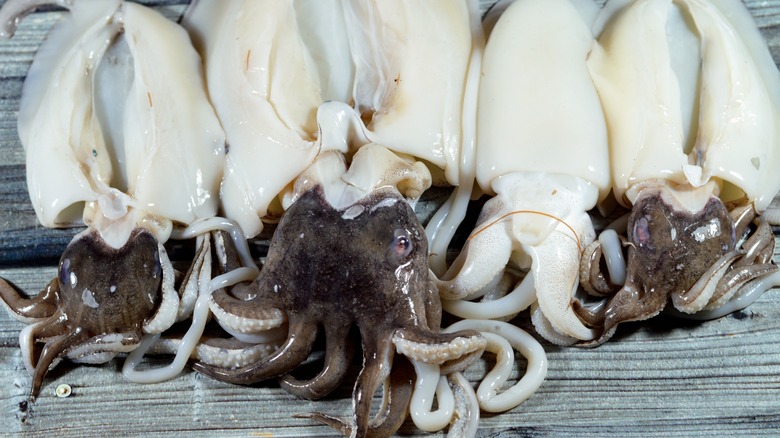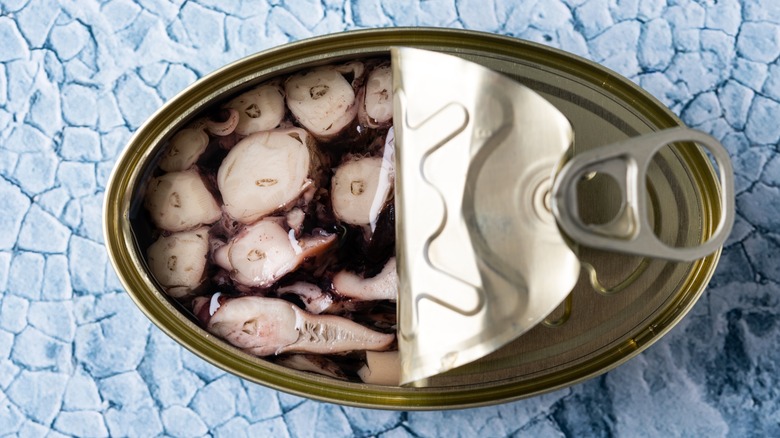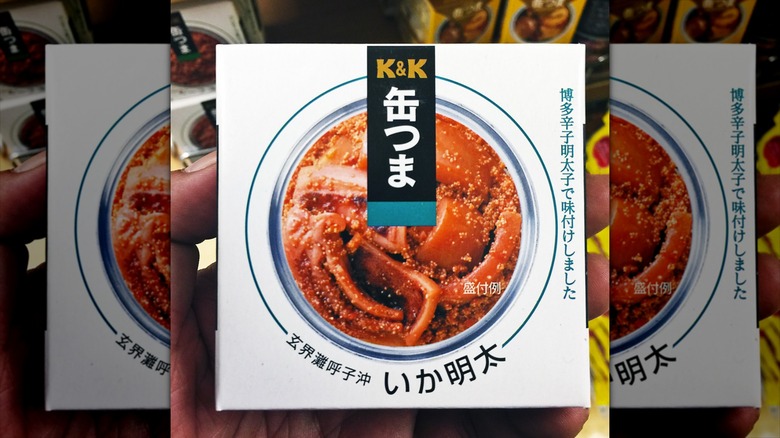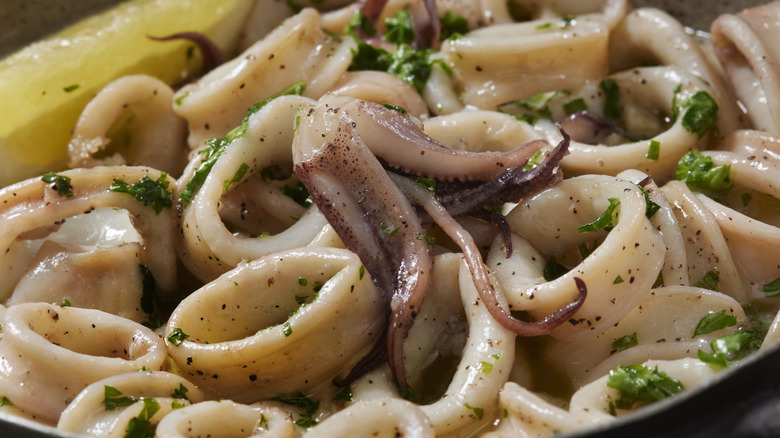Consider Canned Squid For Your Next Pasta Dish And More
The global canned seafood market is expected to hit $50.47 billion by 2030, according to Grand View Research. But if you'd like to get a (salty) taste of what's to come, tinned staples like tuna and anchovies aren't the only options you can try. No longer just fried in calamari or used for their ink in pasta, squid today can be cooked, seasoned, and packed into tins like many of their aquatic brethren, which is an easy way to boost your next pasta dish or another entree.
While canned seafood is a rising trend, consuming these cephalopods is not. Humans have been eating the sea creatures (known by their scientific name Teuthoidea) for centuries, and records of doing so date back to China in 618 CE. In fact, the early Chinese may have dried them and preserved them in salt, paving the way for the canned seafood we see today.
Although wrestling with fresh squid can be quite a task if you're not used to eating it regularly, the tinned version is much simpler to incorporate into your pasta recipes. While I'm a fan of trying all different types of tinned seafood (like mussels, oysters, and sardines), I've yet to get my hands on this particular mollusk. So to get the scoop on canned squid, I turned to organizations like National Geographic to get more information about the mollusk, the U.S. Environmental Protection Agency (EPA) to learn about the canning process, and Healthline and WebMD to discover all its nutritional benefits.
What is canned squid?
Considering there are over 300 types of squid in the world, you can find them in every ocean on the planet — and everything from giant squid to baby squid might make its way into your can. As cephalopods, squid is a close relative of octopus and cuttlefish. While squid have been consumed for centuries in Europe and further east, they first made their way into American cuisine as late as the 1970s. Before that, they were primarily used by fishermen as bait on the East Coast. But when the Cornell Cooperative Extension Division set out to find lesser-known seafood to help stimulate food systems in New York, squid began to take off.
Unlike other protein options, practically the entire squid is edible, including its body, ink, and tentacles. The tinned seafood is typically composed of the squid's body or tentacles, and it's often canned in its own ink to make the flavor even stronger. This ink, which is released when the cephalopods are defending themselves, is a dark liquid that is often used to color food black. The squid meat itself, however, is typically light pink to white and cut into pieces about an inch thick. If not canned in ink, you may see it swimming in olive oil, a special sauce, or water.
How is canned squid made?
Before squid is canned, it's defrosted (if it was initially frozen) and cleaned. Then the seafood may be blanched in brine first, or subsequently cooked for up to 10 hours. The latter gets rid of excess oil (that is sometimes reserved for packing the seafood later on) and makes the squid more malleable. Squid can either be chopped up into bite-sized pieces (with the stuff you don't want to eat discarded) before or after it's cooked, but either way, it then has to be cooled, which can take hours. But when you eat tinned squid, rest assured the seafood has been fully cooked ahead of time at high heat.
When the squid is ready to go, it is sterilized and canned with high-pressure steam. In addition, citric acid is often used in the brine to can squid, as it can add a salty flavor, prevent the flesh from becoming black, and keep the seafood nice and firm while it sits in the tin.
Canned squid vs. octopus
Believe it or not, you can find canned octopus online or at specialty food stores. Just like with squid, you may see it smoked or simply sliced and packed in oil, water, or a sauce. What's less common with octopus, however, is to see it packed in its own ink — although octopus ink is edible and can also be added to food to give it a dark hue. These two types of seafood have many similarities, however: They're both cephalopods, they both have tentacles, they both lack feet, and they both prefer saltwater in warm climates. And if you're not experienced, both can be tough to cook — especially squid, which are typically bigger than octopuses.
That's where the tinned versions come in. While these two sea creatures have similar flavor, octopuses are typically lighter, fresher-tasting, and more tender than their counterparts — perhaps in part because they don't have a shell, unlike squid. Some even say that the taste of octopus reminds them of chicken, while the same can't be said for the chewier, more shellfish-like flavor of squid. But just like its brethren, octopus is a highly nutritious seafood, full of vitamin B12, iron, and copper.
What does canned squid taste like?
Canned squid can be a little tougher and chewier than other types of seafood. Since it's cooked by the time it makes it into your tin, however, it will typically have a smoother, more tender texture than if you were to consume it raw. Think of calamari under the breading — the mollusk there still has a bite to it, but it's easy to chew and swallow. The flavor of canned squid is fishier than octopus, but lighter and milder than other types of seafood, like shrimp, mussels, or oysters. It can also depend on how old the mollusk was when it was harvested — the older the squid, the tougher it will be.
Squid packed in oil will have a richer taste, while the seafood packed in a sauce will take on the flavor of the liquid around it. You may find tins with rings or tentacles, but most commonly you'll see a combination of the two. As you probably know from eating calamari, the bumpy tentacles have much more texture, while the rings are significantly smoother.
How to cook with canned squid
Because it's already cooked, canned squid is incredibly easy to incorporate into your pasta and other recipes — or to eat plain as a snack. If you get one packed in water, you may want to add flavor right after draining in the form of salt, butter, or lemon juice. Just like with other types of tinned seafood (like tuna or sardines), you can eat your squid plain, on crackers, or on toast. If it's packed in olive oil, herbs and spices, or some type of sauce, however, this can make for an even more delicious and simple snack.
But of course, you can also toss your squid into a plethora of recipes for a flavor and protein boost. It's inadvisable to cook your cephalopod any further, which can make the texture rubbery, but you can heat it for a short amount of time.
Add your canned seafood to a bowl of Spanish rice, a plate of colorful tacos, or pasta dishes like squid spaghetti, calamari linguine, and squid fettuccini. Or use it to make a warming entree like seafood soup, chowder, or curry. Make sure to take into account the liquid the squid is canned in before doing so, however, as seafood packed in a sauce or its ink will add a different taste and color to your dish. But if you'd like to forgo liquid entirely, try frying your cephalopod instead to make calamari or Takoyaki.
Where to buy canned squid
Canned squid is rare enough that you may not be able to pick it up at your average grocery store, although you may see it in some big chains, including Walmart. In most cases, you'll want to turn to specialty food stores or online retailers. Many of the latter sell or import their canned squid from the Mediterranean, although you'll see some from the States as well. If you do find it in a store, however, it will likely be next to other types of tinned fish and seafood, like tuna and mussels.
Along with choosing the type of canned squid you'd prefer (i.e. if it's packed in water, oil, or something else), you may want to check the ingredient list and sodium content, as this can vary widely. Lata's Ati Manel Squids in Ink, for instance, contains tomato, sunflower oil, onion, spices, and salt in addition to the seafood in question, while Vigo's Squid in Soy and Olive Oil only features two oils and salt. Prices can range from around $2.99 to $14.99 per can.
Nutritional information about canned squid
The nutritional information of canned squid depends on the liquid it's packed in. For instance, seafood canned in oil will have a higher fat content, and sodium can vary. For instance, Goya Foods' 113-gram can of tinned squid contains 520-540 mg of sodium, while the same amount of Conchita Foods' version has 150 mg, despite the products including similar ingredients. But if your seafood was packed in its own ink, that's good news nutrition-wise. According to Healthline, this dark liquid may have antimicrobial and antioxidant properties, and may even help reduce blood pressure and combat cancer. It's worth looking at the ingredients in the can you're buying for this reason — but in general, squid itself boasts quite a few nutritional benefits.
Like many other types of seafood, the mollusk is high in protein, with just 4 ounces containing 18 grams of the nutrient. It also features plenty of vitamin C, iron, calcium, and omega-3 fatty acids. According to WebMD, squid may assist women through a healthy pregnancy, boost heart health, and quell rheumatoid arthritis. Plus, it's low in mercury compared to other types of seafood. If you are allergic to shellfish, however, you'll want to stay far away from squid.
How to store canned squid
Canned squid can last a good long time if unopened. Keep it in your pantry or cupboard, or in a similar dry, cool (but not cold) environment, and avoid temperatures higher than 100 degrees Fahrenheit. If stored this way, your tin of seafood can last for up to a whopping five years — although if you can your squid at home, it will only last up to a year in the pantry. For optimal freshness, however, try to eat your mollusk within a year from buying it. It's also important to note that any signs of damage to your can — like big dents or holes that could let in air and bacteria — can cause your squid to deteriorate rapidly.
After you've opened your can of seafood, however, it's a different story. Try to eat your squid within two days, and make sure to store it in the fridge when you're not using it. If you crack open your can only to be met with rotten-smelling seafood, toss it out to stay on the safe side.
